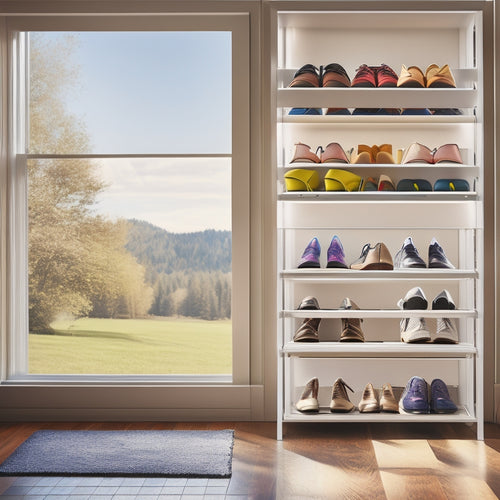
Essential Tools for DIY Enthusiasts
Share
You'll need a solid foundation of essential tools and a well-organized workspace to maximize your full DIY potential. First, prioritize safety with a well-ventilated and well-lit workspace, and invest in a sturdy workbench or table. Next, build your toolbox with must-haves like a tape measure, level, and screwdriver set. Don't underestimate the importance of a hammer and utility knife either. Finally, consider specialized tools like a miter saw and hex key set to take your projects to the next level. With these essentials in place, you'll be ready to tackle any DIY project that comes your way - and discover even more ways to elevate your skills.
Key Takeaways
• Focus on essential tools like a tape measure, level, and screwdriver set for a solid DIY foundation.
• Invest in a miter saw for precise cuts in woodworking projects and a hex key set for assembling furniture.
• Prioritize tool organization and maintenance for longevity and efficiency in your DIY projects.
• Consider the importance of each tool for various DIY tasks and start with the basics before expanding your collection.
• Regularly clean and maintain your tools for optimal performance and to ensure professional-looking results.
Laying the Foundation
As you start on your DIY journey, establishing a solid foundation with the right tools is essential to achieving professional-looking results and avoiding frustrating setbacks.
First and foremost, prioritize DIY safety by ensuring your workspace is well-ventilated, well-lit, and free from tripping hazards. A clear and organized workspace setup will also help you stay focused and efficient.
Invest in a sturdy workbench or table, and consider a pegboard for tool storage. Don't forget to wear protective gear like safety glasses and gloves.
Building Your Toolbox
What tools do you really need to get started with DIY projects, and how do you prioritize your purchases when you're on a budget? Begin by considering the types of projects you want to tackle and the tools required for each. Focus on the essentials, like a tape measure, level, and screwdriver set. These will form the foundation of your toolbox.
| Tool | Description | Importance |
|---|---|---|
| Tape Measure | Measures distances and sizes | High |
| Level | Ensures surfaces are level | High |
| Screwdriver Set | Drives screws and fasteners | High |
| Hammer | Drives nails and fits parts together | Medium |
| Utility Knife | Cuts various materials | Medium |
Proper tool organization and maintenance are critical for efficient project planning. Keep your tools organized, clean, and well-maintained to ensure they last and perform well. By prioritizing your purchases and focusing on the essentials, you'll be well on your way to building a solid toolbox for your DIY projects.
Specialized Tools for Success
You've got the basics covered, now it's time to take your DIY game to the next level with specialized tools that'll help you tackle specific tasks with precision and confidence.
For instance, a miter saw is a must-have for precise cuts in woodworking projects, while a hex key set is essential for assembling furniture.
To guarantee your tools are always within reach, invest in a tool organization system that keeps your workspace tidy and efficient.
Regular tool maintenance is also vital to extend the lifespan of your tools and keep them running smoothly.
With these specialized tools and a well-maintained workspace, you'll be inspired to take on more complex DIY projects and achieve professional-looking results.
Frequently Asked Questions
What Is the Best Way to Organize My Toolbox for Easy Access?
To optimize your toolbox layout, sort tools by frequency of use, store heavy items at the bottom, and utilize storage solutions like dividers and bins to keep small parts organized, making it easy for you to find what you need.
Can I Use a Cordless Drill for All Drilling Tasks?
You're wondering if a cordless drill can handle all drilling tasks? While it's convenient, it has limitations - heavier tasks require more power, and battery life may not suffice, so consider a drill comparison for best task assignment.
Are There Any Safety Precautions for Using Power Tools?
When using power tools, you must prioritize personal protection; always wear safety glasses or goggles for eye safety, and consider ear protection and a dust mask to guarantee a safe and healthy working environment.
How Do I Maintain and Clean My Tools for Optimal Performance?
You should regularly clean your tools with a soft cloth and mild soap to prevent rust, then dry and lubricate them; also, sanitize tools with rubbing alcohol and wear gloves to maintain peak performance.
What Is the Difference Between a Drill and a Driver?
You're wondering what sets a drill apart from a driver? It's all about torque settings and chuck types. A drill typically has fixed torque and a keyed chuck, while a driver offers adjustable torque and a keyless chuck for more versatility.
Related Posts
-

Large Wall Hooks to Maximize Garage Space
You can effectively double your garage's storage capacity by installing large wall hooks that keep items off the floo...
-

Adjustable Modular Shoe Racks for Versatility
Adjustable modular shoe racks are your go-to solution for versatile and organized footwear storage. These racks maxim...
-

Tool Storage Chests for a More Organized Workspace
You're looking to enhance productivity and reduce stress in your workspace by getting your tools organized, and that'...


